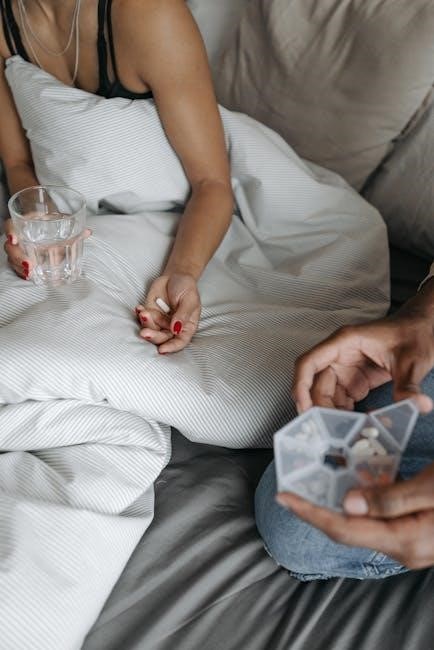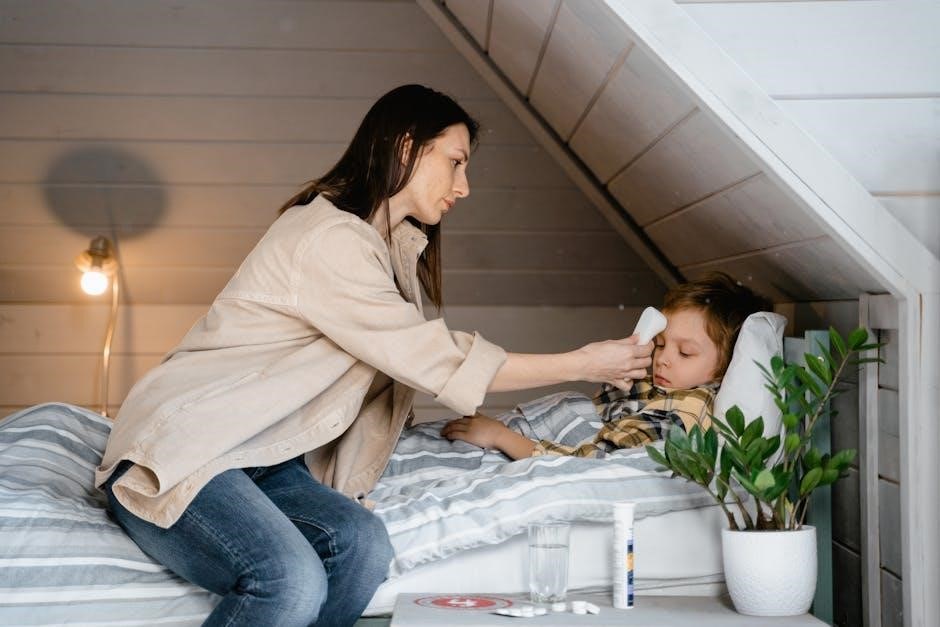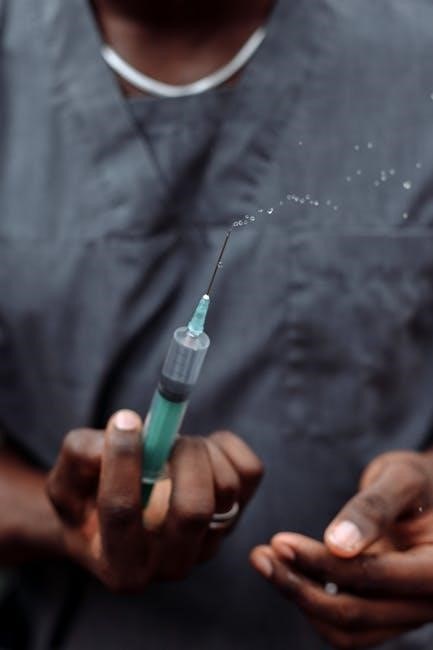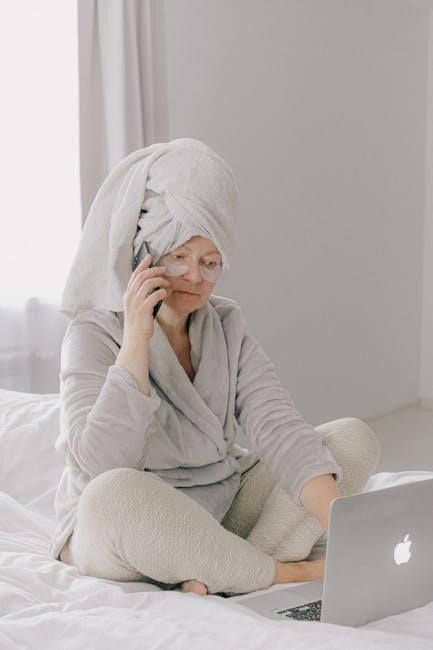
Bed Bath Procedure Nursing PDF: A Comprehensive Guide
This comprehensive guide provides nurses with a detailed overview of the bed bath procedure. From essential steps to post-procedure care, this resource ensures patient hygiene and comfort. Access a printable PDF for easy reference, enhancing your nursing practice and skills.
Bed bath procedures are a fundamental aspect of nursing care, essential for maintaining patient hygiene when traditional bathing methods are not feasible. This introduction will delve into the significance of bed baths, exploring their role in promoting patient well-being and preventing complications. Nurses must master this skill to provide comprehensive care.

A bed bath involves cleansing the patient’s body while they remain in bed, ensuring cleanliness, comfort, and preventing infections. It’s a critical component of holistic care, especially for patients with limited mobility or those unable to bear weight. Understanding the nuances of this procedure is vital for all nursing professionals.
Effective bed bath techniques contribute significantly to patient comfort and overall health. This guide will provide a step-by-step approach, outlining best practices and essential considerations. By mastering these techniques, nurses can deliver high-quality care, improving patient outcomes and fostering a supportive environment.
Purpose of Bed Baths in Nursing Care
The primary purpose of bed baths in nursing care is to maintain patient hygiene, especially when patients are unable to bathe themselves due to mobility issues, post-surgery recovery, or other health conditions. Regular bed baths help prevent skin breakdown, infections, and pressure ulcers, ensuring the patient’s physical well-being.
Beyond hygiene, bed baths offer therapeutic benefits. They stimulate circulation, promote relaxation, and provide an opportunity for nurses to assess the patient’s skin condition. This assessment is crucial for early detection of potential problems, allowing for timely intervention and preventing further complications.
Furthermore, bed baths enhance patient comfort and self-esteem. Feeling clean and refreshed can significantly improve a patient’s mood and overall sense of well-being. This interaction also fosters a stronger nurse-patient relationship, built on trust and compassionate care. Bed baths are thus a vital component of holistic nursing practice.
Preventing Infections Through Bed Baths

Bed baths play a critical role in preventing infections by removing bacteria, dirt, and other pathogens from the patient’s skin. By maintaining skin integrity and cleanliness, bed baths reduce the risk of skin infections, such as cellulitis and folliculitis, which can be particularly dangerous for immunocompromised individuals or those with chronic illnesses.
Proper technique is essential to maximize the infection prevention benefits. This includes using clean washcloths and basins for each body area to avoid cross-contamination. Washing from clean to dirty areas, such as starting with the face and moving downwards, further minimizes the spread of pathogens.
Additionally, using appropriate cleansing agents, like mild, pH-balanced soaps, helps maintain the skin’s natural barrier function. Thorough drying after washing prevents moisture buildup, which can promote fungal growth. Regular bed baths are therefore a cornerstone of infection control practices in nursing care, safeguarding patient health.
Maintaining Patient Hygiene with Bed Baths
Bed baths are instrumental in maintaining patient hygiene, particularly for individuals who are bedridden or have limited mobility. Regular cleansing removes sweat, dead skin cells, and other bodily secretions, preventing odor and discomfort. Good hygiene also promotes skin health, reducing the risk of irritation, rashes, and pressure ulcers.
The process of a bed bath involves washing all areas of the body, including the face, neck, arms, chest, abdomen, legs, and perineal area. Special attention is given to skin folds and areas prone to moisture accumulation. This comprehensive approach ensures that the patient remains clean and comfortable, fostering a sense of well-being.
Furthermore, bed baths provide an opportunity for nurses to assess the patient’s skin condition, identifying any potential issues early on. This proactive approach allows for timely intervention and prevents minor problems from escalating into more serious complications. Maintaining patient hygiene through bed baths is therefore essential for overall health and quality of life.

Indications for Bed Baths
Bed baths are indicated for patients with limited mobility, those unable to bear weight, or individuals who are too weak to shower or bathe independently. These situations necessitate bed baths to maintain hygiene and prevent complications.
Patients Unable to Bear Weight
Patients who are unable to bear weight often require bed baths as a primary means of maintaining personal hygiene. This inability can stem from various causes, including post-surgical recovery, severe injuries, or debilitating medical conditions that affect lower extremity strength and stability.
Following surgeries such as hip replacements or major leg trauma, patients are typically restricted from placing weight on the affected limb. Similarly, individuals with conditions like advanced arthritis, fractures, or severe infections may experience significant pain or instability, making it impossible to stand or walk safely. In these cases, bed baths offer a safe and effective alternative to traditional bathing methods.
Providing bed baths ensures these patients receive essential hygiene care, preventing skin breakdown, infections, and discomfort. This is especially crucial because prolonged immobility can increase the risk of pressure ulcers and other complications related to poor hygiene. Bed baths allow nurses and caregivers to cleanse the skin, promote circulation, and assess the patient’s overall condition without requiring them to move or exert themselves excessively.
Patients with Limited Mobility
Patients experiencing limited mobility often benefit significantly from bed baths, as their ability to perform personal hygiene tasks independently is compromised. This limitation can arise from various conditions such as stroke, paralysis, severe arthritis, or advanced stages of chronic diseases. Reduced mobility makes it challenging, if not impossible, for these individuals to safely access and use traditional bathing facilities.
For instance, stroke survivors may have hemiparesis, which weakens one side of their body, making it difficult to maintain balance or coordinate movements needed for showering or bathing. Similarly, those with advanced arthritis may experience joint pain and stiffness, hindering their ability to move freely and comfortably;
Bed baths provide a practical solution for maintaining hygiene and preventing skin breakdown in these patients. The procedure allows caregivers to cleanse the patient’s skin, assess for any signs of irritation or infection, and promote circulation without requiring the patient to move extensively. This ensures that patients with limited mobility receive essential care, improving their overall comfort and well-being while minimizing the risk of complications associated with poor hygiene.

Essential Steps in Performing a Bed Bath
Performing a bed bath involves several key steps to ensure patient comfort and hygiene. These include gathering supplies, explaining the procedure, ensuring privacy, maintaining warmth, washing in sections, and thorough drying. Each step is crucial for effective care.
Gathering Necessary Supplies
Before initiating a bed bath, assembling all required supplies is paramount for efficiency and patient comfort. Essential items include a basin filled with warm water, maintaining a comfortable temperature to prevent chilling. You’ll also need mild soap for cleansing, ensuring it is gentle on the skin to avoid irritation.
Six washcloths should be readily available for washing and rinsing different body areas, promoting hygiene by preventing cross-contamination. Two large towels are necessary for thoroughly drying the patient after washing, preventing skin breakdown.
Additionally, gather lotion for moisturizing the skin, helping to maintain skin integrity and prevent dryness. Clean clothes or a gown should be prepared for the patient to wear after the bath. Don’t forget a linen bag or hamper for disposing of used linens and maintaining a clean environment.
Gloves are crucial for maintaining infection control and protecting both the nurse and the patient. A barrier, such as a waterproof pad, is also essential to protect the bed linens from becoming wet during the procedure. Proper organization of these supplies streamlines the bed bath process and ensures a comfortable experience for the patient.
Explaining the Procedure to the Patient
Prior to commencing a bed bath, clear and thorough communication with the patient is essential. Begin by introducing yourself and explaining the purpose of the bed bath, emphasizing its role in maintaining hygiene and preventing infections. Discuss the steps involved in the procedure, detailing which body parts will be washed and the sequence in which it will occur.
It is crucial to inquire about the patient’s preferences, such as preferred water temperature or specific areas needing extra attention. Addressing any concerns or anxieties the patient may have can help alleviate discomfort and promote cooperation. Explain the importance of their participation, if possible, such as assisting with turning or holding limbs.
Additionally, inform the patient that their privacy will be respected throughout the process by using curtains or screens. Obtain verbal consent before proceeding to ensure they are comfortable and willing to proceed. Adapt the explanation to the patient’s cognitive and physical abilities, using simple language and providing reassurance as needed.
By fostering open communication and involving the patient in the process, you can create a more comfortable and dignified experience, promoting trust and cooperation during the bed bath.
Ensuring Patient Privacy
Maintaining patient privacy is paramount during a bed bath procedure. Before starting, ensure the room is adequately private by closing the door and drawing the curtains or using a privacy screen to shield the patient from view. Communicate clearly to the patient that their privacy will be respected throughout the entire process.
Avoid unnecessary exposure of the patient’s body by only uncovering the specific area being washed at that moment. Use a bath blanket to cover the rest of the body, providing warmth and minimizing exposure. Work efficiently to complete the bath promptly while still maintaining thoroughness and attention to detail.
Be mindful of the patient’s modesty and avoid making any comments that could cause embarrassment or discomfort. If the patient has any visitors, politely ask them to step out of the room during the bed bath to ensure complete privacy.
Throughout the procedure, remain professional and respectful, treating the patient with dignity and empathy. By prioritizing patient privacy, you create a safe and comfortable environment that fosters trust and cooperation;
Maintaining Warmth and Comfort
Maintaining patient warmth and comfort is crucial during a bed bath. Begin by ensuring the room temperature is warm enough to prevent chills. Close windows and doors to eliminate drafts. Provide a bath blanket to cover the patient, exposing only the area being washed.
Use warm water for washing, checking the temperature to avoid burns. Keep the water warm throughout the procedure by changing it as needed. Gently pat the skin dry after washing each area to prevent chilling. Avoid leaving wet areas exposed;
Communicate with the patient, asking about their comfort level and adjusting the water temperature or blanket as needed. Provide extra blankets if the patient feels cold. Use gentle, soothing motions while washing to promote relaxation.
Position the patient comfortably and use pillows to support their body if necessary. Encourage them to communicate any discomfort or needs. Maintain a calm and reassuring demeanor.
By prioritizing warmth and comfort, you can create a positive experience for the patient, promoting relaxation and cooperation during the bed bath procedure.
Washing the Patient in Sections
To effectively wash the patient during a bed bath, divide the body into sections, ensuring each area receives thorough cleaning while maintaining the patient’s dignity and warmth. Start with the face, using a clean, damp washcloth to gently cleanse the eyes, face, and neck.
Next, move to the arms and hands, washing one at a time. Pay attention to areas like the armpits and between the fingers. Proceed to the chest and abdomen, including skin folds.
Continue to the legs and feet, washing one leg at a time. Clean between the toes and ensure thorough drying. Finally, assist the patient to turn onto their side to wash the back and buttocks. Pay close attention to pressure points to prevent skin breakdown.
Use a clean washcloth for each section to prevent cross-contamination. Rinse and dry each area thoroughly after washing. Maintain a consistent flow, communicating with the patient throughout the procedure.
By washing in sections, you can ensure thorough hygiene while minimizing discomfort and exposure for the patient. This approach promotes efficiency and patient comfort.
Drying the Patient Thoroughly
After washing each section of the patient’s body during a bed bath, it is crucial to ensure they are dried thoroughly. Proper drying prevents skin irritation, breakdown, and the growth of bacteria or fungi. Use a clean, soft towel to gently pat the skin dry, avoiding harsh rubbing which can damage delicate skin.
Pay special attention to areas where moisture can accumulate, such as skin folds, between the toes, under the breasts, and in the groin area. These areas are prone to maceration and infection if not dried adequately.
Ensure that the towel is dry and absorbent to effectively remove all traces of water. If necessary, use a fresh towel for different body sections to maintain hygiene. Be especially gentle when drying areas with sensitive skin or pressure points.
Observe the patient’s skin for any signs of redness, irritation, or breakdown during the drying process. If any abnormalities are noted, document and report them appropriately.
Thorough drying contributes significantly to the patient’s comfort and helps maintain skin integrity. Take your time and ensure every area is completely dry before moving on to the next step in the bed bath procedure.

Post-Procedure Care
After completing the bed bath, focus on patient comfort and safety. Ensure the bed is low, locked, and the call light is within reach. Document the procedure and any observations, promoting ongoing patient well-being.
Assessing Patient Comfort
Post-procedure, a crucial step involves thoroughly assessing the patient’s comfort. Begin by engaging in verbal communication, directly asking the patient about their well-being and any discomforts they may be experiencing. Pay close attention to their verbal cues and responses, noting any specific areas of concern or sensitivity.

Non-verbal cues are equally important. Observe the patient’s facial expressions, body language, and overall demeanor for signs of pain, coldness, or anxiety. Look for any signs of shivering, grimacing, or restlessness, which could indicate that the patient is not entirely comfortable.
Inquire about skin integrity and any potential irritation caused by the bathing process. Ask if the water temperature was appropriate and if any areas feel overly dry or sensitive. Address any concerns promptly by applying lotion to dry areas or adjusting the bedding for optimal comfort. Ensure that the patient feels secure, warm, and relaxed following the bed bath.
Ensuring Bed is Low and Locked
Following the bed bath, a critical safety measure is to ensure the bed is in the lowest possible position and that the wheels are securely locked. This step is paramount for preventing falls and ensuring the patient’s safety and well-being. Lowering the bed reduces the distance a patient would fall if they attempt to get out of bed unassisted.
Before leaving the patient’s bedside, double-check that the bed’s wheels are locked. Engage the locking mechanism on each wheel to prevent any unintended movement. This measure is particularly important for patients who may be confused, disoriented, or have limited mobility, as they may inadvertently try to adjust their position or exit the bed without realizing the potential risks.
A low and locked bed provides a stable and secure environment, minimizing the risk of falls and promoting patient safety. This simple yet essential step contributes significantly to a safe and comfortable recovery.

Providing Access to Call Light
After completing the bed bath and ensuring the patient’s comfort, a crucial step is to provide them with easy access to the call light. The call light is the patient’s direct line of communication to the nursing staff, allowing them to request assistance, report discomfort, or address any concerns they may have. Placing the call light within the patient’s reach empowers them to seek help whenever needed, promoting a sense of security and control.
Position the call light on the bed near the patient’s hand, ensuring they can easily grasp it without straining or reaching excessively. Verify that the call light is functioning correctly by testing it to confirm that the nursing station receives the signal. Explain to the patient how to use the call light and encourage them to use it whenever they require assistance, regardless of how minor their needs may seem.
Prompt access to the call light enhances patient safety, promotes independence, and fosters a trusting relationship between the patient and the healthcare team.

Documentation

Accurate and thorough documentation following a bed bath is essential for maintaining comprehensive patient records and ensuring continuity of care. Documentation serves as a legal record of the care provided, facilitates communication among healthcare team members, and helps track patient progress and identify any potential issues.
The documentation should include the date and time of the bed bath, the patient’s skin condition before and after the procedure, any observed skin breakdown or abnormalities, and the patient’s tolerance of the procedure. Note any specific areas of concern, such as pressure points or areas prone to skin irritation. Record any assistance the patient required during the bath, as well as any specific products used, such as soaps, lotions, or barrier creams.
Include any relevant observations, such as the patient’s level of participation, emotional state, and any complaints or concerns they expressed. Document any teaching or education provided to the patient regarding hygiene practices. Sign and date the documentation, ensuring it is legible and accurate.
Leave a Reply
You must be logged in to post a comment.